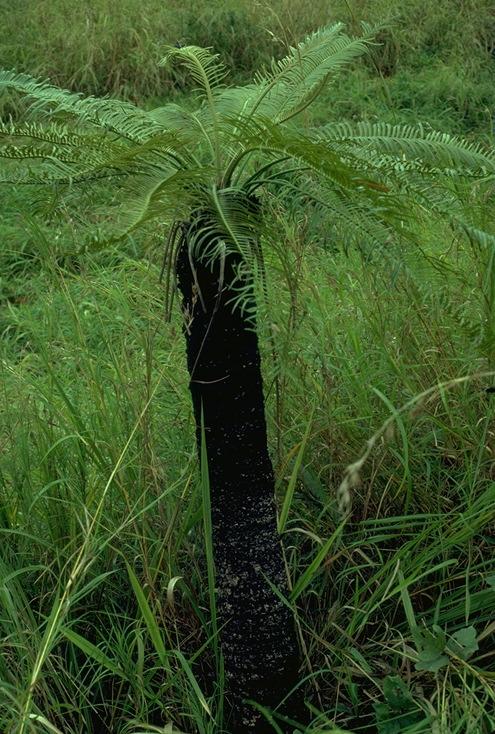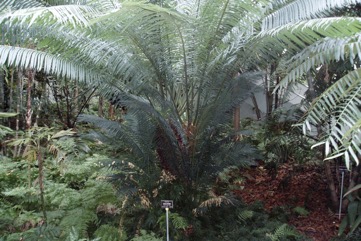Queen sago, Sago cycad

A tropical plant. It occurs locally and near the sea. It is widely distributed in the Philippines. They occur in lowland areas in grassland and forest. They grow from sea level to 700 m altitude. They are more common in places with a dry seasonal climate. In India they grow up to 1000 m altitude. It suits hardiness zones 10-12.
Also known as:
Bitogo, Canningay, Chin-mondaing, Enthu, Fadang, Faho, Indapana, Intalappana, Jangli-madan-mast-ka-phul, Kamkshi, Limel, Logologo, Madanagama, Madu, Mundicalu, Mwel, Mwele, Mol, Ni-baam, Oruguna, Pakis haji, Pakis raja, Pitogo, Te bam, Varaguna
Edible Portion
- Seeds, Caution, Leaves, Pith, Shoots
Where does Queen sago grow?
Found in: Africa, Asia, Australia, Caribbean, East Africa, Fiji, Guam, India, Indochina, Indonesia, Kiribati, Madagascar, Malaysia, Mariana Islands, Marquesas, Marshall Islands, Micronesia, Myanmar, Nauru, New Caledonia, Pacific, Palau, Papua New Guinea, PNG, Philippines, SE Asia, Singapore, Sri Lanka, Thailand, Tonga, Vanuatu, Vietnam, Yap
Notes: There are about 20-40 Cycas species. Some of these in Papua New Guinea are now classified as Cycas apoa.
Growing Queen sago, Sago cycad
Cultivation: They can be grown from seeds. Plants, especially damaged ones, produce suckers.
Edible Uses: The pith is processed to extract the starch during times of food shortage. The seeds are sometimes eaten after treatment by slicing, fermenting for 2 weeks and then cooking. The very young leaves are cooked and eaten in Malaysia. CAUTION The young leaves are poisonous to cattle. The seeds are poisonous unless treated. They contain a toxic glucoside. It can cause brain damage and cancer.
Production: It is a slow growing plant. Plants for sago need to be 7 years old and not to have flowered.
Nutrition Info
per 100g edible portion| Edible Part | Energy (kcal) | Protein (g) | Iron (mg) | Vitamin A (ug) | Vitamin c (mg) | Zinc (mg) | % Water |
|---|---|---|---|---|---|---|---|
| - | - | - | - | - | - |
Queen sago, Sago cycad Photos


References
Ambasta, S.P. (Ed.), 2000, The Useful Plants of India. CSIR India. p 153
Arinathan, V., et al, 2007, Wild edibles used by Palliyars of the western Ghats, Tamil Nadu. Indian Journal of Traditional Knowledge. 6(1) pp 163-168
Ashton, M. S., et al 1997, A Field Guide to the Common Trees and Shrubs of Sri Lanka. WHT Publications Ltd. pdf p 63 Barrau, J., 1976, Subsistence Agriculture in Melanesia. Bernice P. Bishop Museu, Bulletin 219 Honolulu Hawaii. Kraus reprint. p 50
Bole, P.V., & Yaghani, Y., 1985, Field Guide to the Common Trees of India. OUP p 33
Borrell, O.W., 1989, An Annotated Checklist of the Flora of Kairiru Island, New Guinea. Marcellin College, Victoria Australia. p 11
Bourret, D., 1981, Bonnes-Plantes de Nouvelle-Caledonie et des Loyaute. ORSTOM. p 73
Brickell, C. (Ed.), 1999, The Royal Horticultural Society A-Z Encyclopedia of Garden Plants. Convent Garden Books. p 326
Brouk, B., 1975, Plants Consumed by Man. Academic Press, London. p 227
Brown, W.H., 1920, Wild Food Plants of the Philippines. Bureau of Forestry Bulletin No. 21 Manila. p 19
Burkill, I.H., 1966, A Dictionary of the Economic Products of the Malay Peninsula. Ministry of Agriculture and Cooperatives, Kuala Lumpur, Malaysia. Vol 1 (A-H) p 729
Cabalion, P. and Morat, P., 1983, Introduction le vegetation, la flore et aux noms vernaculaires de l'ile de Pentcoste (Vanuatu), In: Journal d'agriculture traditionnelle et de botanique appliquee JATBA Vol. 30, 3-4
Clarke, W.C. & Thaman, R.R., 1993, Agroforestry in the Pacific Islands: Systems for sustainability. United Nations University Press. New York. p 235
Cundall, P., (ed.), 2004, Gardening Australia: flora: the gardener's bible. ABC Books. p 449
Etherington, K., & Imwold, D., (Eds), 2001, Botanica's Trees & Shrubs. The illustrated A-Z of over 8500 trees and shrubs. Random House, Australia. p 248
Facciola, S., 1998, Cornucopia 2: a Source Book of Edible Plants. Kampong Publications, p 90
French, B.R., 1986, Food Plants of Papua New Guinea, A Compendium. Asia Pacific Science Foundation p 339
Garcia, G. S. C., 2006, The mother-child nexus. Knowledge and valuation of wild food plants in Wayanad, Western Ghats, India. Journal of Ethnobiology and Ethnomedicine, 2:39
Hedrick, U.P., 1919, (Ed.), Sturtevant's edible plants of the world. p 256
Henty, E.E., & Pritchard, G.S., 1973, Weeds of New Guinea and their control. Botany Bulletin No 7, Division of Botany, Lae, PNG. p 27
Henty, E.E., 1980, Harmful Plants in Papua New Guinea. Botany Bulletin No 12. Division Botany, Lae, Papua New Guinea. p 44, 46
Hibbert, M., 2002, The Aussie Plant Finder 2002, Florilegium. p 79
Johns, R.J., 1976, Common Forest Trees of Papua New Guinea. Part 1 Gymnospermae, Forestry College Bulolo, PNG p 4
Jones, D.L., 2000, Cycads of the world. Reed New Holland. p 137
Lacuna-Richman, C., 2006, The use of non-wood forest products by migrants in a new settlement: experiences of a Visayan community in Palawan, Philippines. Journal of Ethnobiology and Ethnomedicine. 2:36
Lugod, G.C. and de Padua L.S., 1979, Wild Food Plants in the Philippines. Vol. 1. Univ. of Philippines Los Banos. p 32
Macmillan, H.F. (Revised Barlow, H.S., et al), 1991, Tropical Planting and Gardening. Sixth edition. Malayan Nature Society. Kuala Lumpur. p 356
Martin, F.W. & Ruberte, R.M., 1979, Edible Leaves of the Tropics. Antillian College Press, Mayaguez, Puerto Rico. p 190
Martin, F. W., et al, 1987, Perennial Edible Fruits of the Tropics. USDA Handbook 642 p 25
McClatchey, W. C., 2012, Wild food plants of Remote Oceania. Acta Societatis Botanicorum Poloniae 81(4) 371-380
Menninger, E.A., 1977, Edible Nuts of the World. Horticultural Books. Florida p 162
Nurfadilah, S., et al, 2017, Species richness, conservation status, and potential uses of plants in Segara Anakan Area of Sempu Island, East Java, Indonesia. BIODIVERSITAS. Volume 18, Number 4,
Parham, H. B. R, 1940, Supplement to the Journal of the Polynesian Society No. 16. Fiji Plants: Their Name and Uses.
Pham-Hoang Ho, 1999, An Illustrated Flora of Vietnam. Nha Xuat Ban Tre. p 213
Plants for a Future database, The Field, Penpol, Lostwithiel, Cornwall, PL22 0NG, UK. http://www.scs.leeds.ac.uk/pfaf/
Prasad, P.N., & Abraham, Z., 1984, Ethnobotany of the Nayads of North kerala. J. Econ. Tax. Bot. Vol. 5 No. 1 pp 41-
Rajapaksha, U., 1998, Traditional Food Plants in Sri Lanka. HARTI, Sri Lanka. p 175
Rasingam, L., 2012, Ethnobotanical studies on the wild edible plants of Irula tribes of Pillur Valley, Coimbatore district, Tamil Nadu, India. Asian Pacific Journal of Tropical Biomedicine. (2012) S1493-S1497
Sahni, K.C., 2000, The Book of Indian Trees. Bombay Natural History Society. Oxford. p 192
Sp. pl. 2:1188. 1753
Staples, G.W. and Herbst, D.R., 2005, A tropical Garden Flora. Bishop Museum Press, Honolulu, Hawaii. p 68
Stone, B. C., 1970, The Flora of Guam. A Manual for the Identification of the Vascular Plants of the Island. Micronesica. Journal of the University of Guam. p 65
Thaman, R.R., 1976, The Tongan Agricultural System, University of the South Pacific, Suva, Fiji. p 394
Thaman, R. R., 1987, Plants of Kiribati: A listing and analysis of vernacular names. Atoll Research Bulletin No. 296
Thaman, R. R., et al, 1994, The Flora of Nauru. Atoll Research Bulletin No. 392. Smithsonian Institute p 37
Vander Velde, N, 2003, The Vascular Plants of Majuro Atoll, Republic of the Marshall Islands. Atoll research Bulletin. No. 503. Smithsonian Institute. p 16
Yuncker, T.G., 1959, Plants of Tonga, Bernice P. Bishop Museum, Hawaii, Bulletin 220. p 45